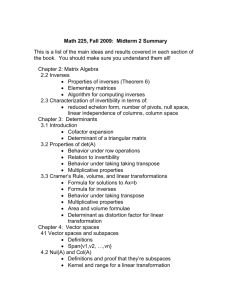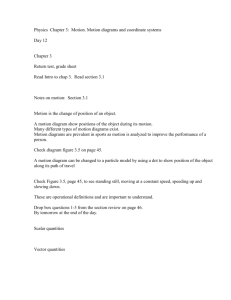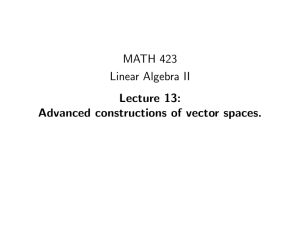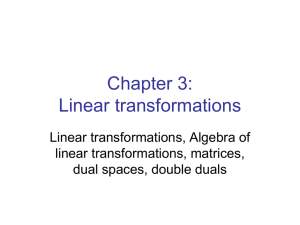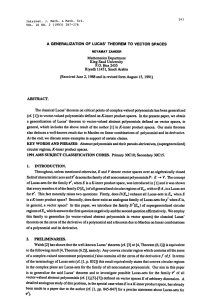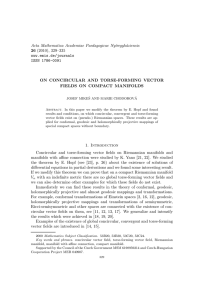Notes 3
advertisement
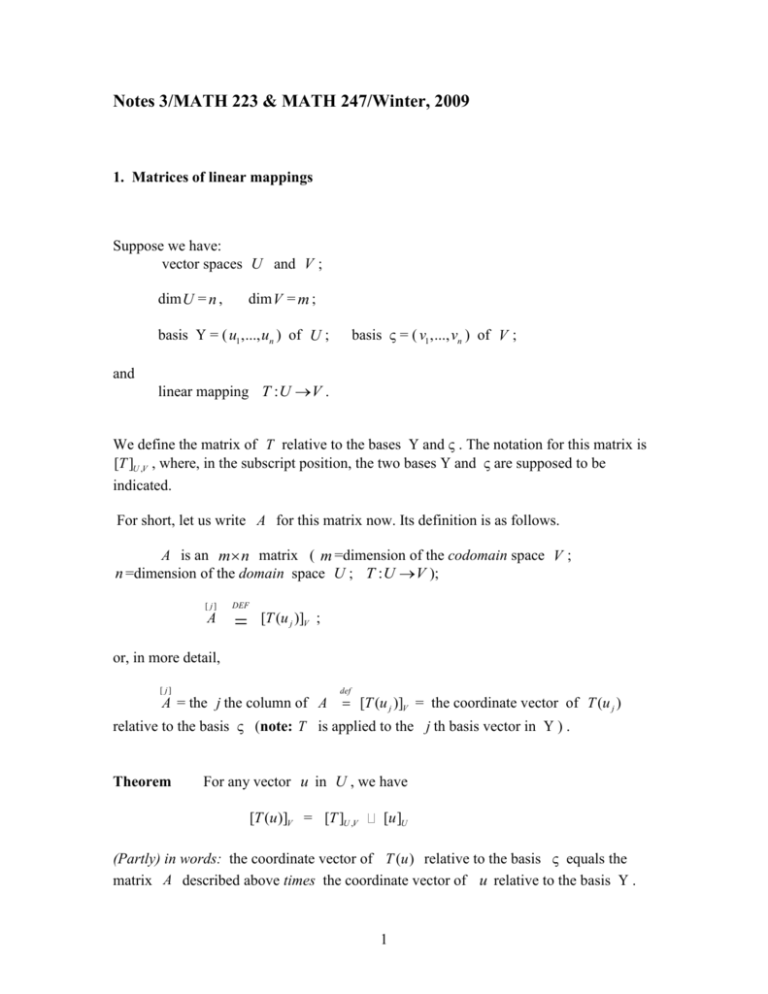
Notes 3/MATH 223 & MATH 247/Winter, 2009 1. Matrices of linear mappings Suppose we have: vector spaces U and V ; dim U = n , dim V = m ; basis = ( u1,..., un ) of U ; and basis = ( v1 ,..., vn ) of V ; linear mapping T : U V . We define the matrix of T relative to the bases and .The notation for this matrix is [T ]U ,V , where, in the subscript position, the two bases and are supposed to be indicated. For short, let us write A for this matrix now. Its definition is as follows. A is an m n matrix ( m =dimension of the codomain space V ; n =dimension of the domain space U ; T : U V ); [ j] A DEF [T (u j )]V ; or, in more detail, [ j] def A = the j the column of A [T (u j )]V = the coordinate vector of T (u j ) relative to the basis (note: T is applied to the j th basis vector in ) . Theorem For any vector u in U , we have [T (u )]V = [T ]U ,V [u ]U (Partly) in words: the coordinate vector of T (u ) relative to the basis equals the matrix A described above times the coordinate vector of u relative to the basis . 1 n Let be ( x1,..., xn ) tr . Then u x j u j . Therefore, since T is linear, Proof j 1 T (u ) n x j 1 j T (u j ) . Thus, [T (u )]V n j 1 x j [T (u j )]V = n x j 1 [ j] j A = A ( x1,..., xn ) tr = A [u ]U . Here, we made use of the fact that “taking coordinate vectors is a linear operation”: [ w1 w2 ]V [ w1 ]V [ w21 ]V ; and [a w]V a [ w]V . Most common special case: when U V , and = . Now, T : V V is a linear operator. We abbreviate [T ]U ,V as [T ]U . The columns of [T ]U are the coordinate vectors [T (u j )]U , for j 1,..., n ; and the equality of the theorem becomes, for arbitrary v in V : [T (v)]U = [T ]U [v]U . Example 1. U = R 2 , V R 3 ; n 2 , m 3 ; = (2) = (e1, e2 ) , the standard basis of R 2 , = (3) = (eˆ1 , eˆ2 , eˆ3 ) , the standard basis of R 3 ; T : R 2 R 3 defined by the formula x y x T ( ) x 2 y y 3x 4 y 1 0 1 1 Now: T (e1 ) = T ( ) = 1 2 0 = 1 ; 0 3 1 4 0 3 2 0 1 1 0 T (e2 ) = T ( ) = 0 2 1 = 2 1 3 0 4 1 4 The matrix A = [T ]U ,V is 1 1 A = [ [T (e1 )]E , [T (e2 )]E ] = [ T (e1 ) , T (e2 ) ] = 1 2 . 3 4 4 Given, as an example, u , we have: [u ]U = [u ]E = u ; 7 4 7 11 4 T (u ) = T ( ) 4 2 7 = 10 ; [T (u )]E = T (u ) = 7 3 4 4 7 16 11 10 . 16 On the other hand: 1 1 A [u ]E = A u = 1 2 3 4 1 4 1 7 11 4 = 1 4 2 7 = 10 7 (3) 4 4 7 16 We see that the theorem is verified in this special case (which, of course, is not a proof of the theorem itself). But we see even more: not only that the results of the two calculations are the same, but also, that the intermediate expressions are also, essentially, the same. The theorem itself has a very easy proof, one that is not more complicated than the calculations above. Example 2. The spaces U and V , as well as the mapping T the same as in Example 1; the bases (u1, u2 ) , (v1, v2 , v3 ) consist of vectors defined as follows: 2 1 u1 , u2 ; 1 3 1 0 1 v1 0 , v2 2 , v3 1 . 2 1 1 3 2 1 3 2 Now: T (u1 ) = T ( ) = 2 2 (1) = 0 ; 1 3 (2) 4 (1) 2 1 3 4 1 T (u2 ) = T ( ) = 1 2 3 = 5 3 3 1 4 3 7 r But, now we need [T (u1 )]V and [T (u2 )]V . If [T (u1 )]V = s , then t 3 1 0 1 T (u1 ) = 0 = r v1 s v2 t v3 = r 0 s 2 t 1 ; 2 2 1 1 which means that (!) 3 1 0 1 = 0 0 2 1 2 2 1 1 r s t 1 0 1 Denoting the matrix 0 2 1 by P , and accepting the fact that P is invertible, 2 1 1 this means that r = 1 P s t 3 0 2 [ P is the so-called transition, or change-of-basis, matrix for the change of basis from , the standard basis in R 3 , to the “new” basis (v1, v2 , v3 ) . Later, there will be more on “change-of-basis”.] We can calculate 4 P 1 3 1 2 = 2 1 1 ; and so 4 1 2 [T (u1 )]V r 3 1 2 3 = s = 2 1 1 0 = t 4 1 2 2 5 . 4 8 Similarly, [T (u2 )]V = P 1 3 1 2 4 31 T (u2 ) = 2 1 1 5 = 20 . 4 1 2 7 35 Thus, the matrix A = [T ]U ,V is A = [ [T (u1 )]V , [T (u2 )]V ] = 5 31 4 20 . 8 35 The last matrix A can be used directly to calculate T (u ) if u is given in the form u a u1 b u2 ; the result will be given in the form T (u ) r v1 s v2 t v3 . 3 For instance, let u 3 u1 5 u2 . Then [u ]U = , and thus 5 5 31 [T (u )]V = A [u ]U = 4 20 8 35 170 3 = 112 , 5 199 which means that T (u) 170 v1 112 v2 199 v3 . If we want to check this result , then we calculate 2 1 11 u 3 u1 5 u2 = 3 5 = ; 1 3 18 5 (*) from the definition of T directly: 11 18 29 11 = T (u ) T ( 25 ; ) 11 2 (18) 18 3 (11) 4 (18) 39 On the other hand, from the formula (*) 1 0 1 29 T (u) 170 v1 112 v2 199 v3 = 170 0 112 2 199 1 = 25 ; 2 1 1 39 unbelievably, the same! U = R 23 , V = R 22 ; Example 3. = ( E1,1 , E1,2 , E1,3 , E2,1 , E2,2 , E2,3 ), the standard basis of R 23 : 1 0 0 0 1 0 0 0 1 E1,1 , E1,2 , E1,3 0 0 0 0 0 0 0 0 0 0 0 0 0 0 0 0 0 0 E2,1 , E2,2 , E2,3 1 0 0 0 1 0 0 0 1 = ( Eˆ1,1, Eˆ1,2 , Eˆ 2,1 , Eˆ 2,2 ), the standard basis of R 22 : 1 0 ˆ 0 1 ˆ 0 0 ˆ 0 0 Eˆ1,1 , E1,2 , E2,1 , E2,2 ; 0 0 0 0 1 0 0 1 T :R 23 R 22 1 2 defined by T ( X ) X B , with the fixed matrix B 3 4 . 5 6 First of all, it is easy to see, without calculation, that T so defined is a linear mapping: 6 T ( X1 X 2 ) ( X1 X 2 ) B X1 B X 2 B T ( X1 ) T ( X 2 ) ; and similarly for the other condition. We have that dim( U )=6 , dim( V )=4. thus, the matrix A [T ]U ,V is a 4 6 matrix. The columns of A are [T ( E1,1 )]V , [T ( E1,2 )]V , [T ( E1,3 )]V , [T ( E2,1)]V , [T ( E2,2 )]V , [T ( E2,3 )]V . We need to calculate the values at hand. 1 0 0 T ( E1,1 ) = 0 0 0 1 2 1 2 ˆ ˆ ˆ ˆ = 3 4 = 1 E1,1 2 E1,2 0 E2,1 0 E2,2 , 0 0 5 6 0 1 0 T ( E1,2 ) = 0 0 0 1 2 3 4 ˆ ˆ ˆ ˆ = 3 4 = 3 E1,1 4 E1,2 0 E2,1 0 E2,2 , 0 0 5 6 0 0 1 T ( E1,3 ) = 0 0 0 1 2 5 6 ˆ ˆ ˆ ˆ 3 4 = 0 0 = 5 E1,1 6 E1,2 0 E2,1 0 E2,2 5 6 0 0 0 T ( E2,1 ) = 1 0 0 1 2 0 0 ˆ ˆ ˆ ˆ 3 4 = 1 2 = 0 E1,1 0 E1,2 1 E2,1 2 E2,2 5 6 0 0 0 T ( E2,2 ) = 0 1 0 1 2 0 0 ˆ ˆ ˆ ˆ 3 4 = 3 4 = 0 E1,1 0 E1,2 3 E2,1 4 E2,2 5 6 0 0 0 T ( E2,3 ) = 0 0 1 1 2 0 0 ˆ ˆ ˆ ˆ 3 4 = 5 6 = 0 E1,1 0 E1,2 5 E2,1 6 E2,2 ; 5 6 from which, the matrix A [T ]U ,V is 7 1 2 A = 0 0 3 5 0 0 0 4 6 0 0 0 0 0 1 3 5 0 0 2 4 6 2. Composition of linear mappings Suppose we have vector spaces U , V , and W . Let us also suppose that we have linear mappings S and T as in S T U V W . Then we can form the composite linear mapping T S : U W , defined as follows: (T S )(u ) T (S (u )) . In other words, T S is applied to any u U by first applying S to u , and then, applying T to the result S (u ) . Since the domain of T is supposed to coincide with the codomain of S , the space V , and S (u ) is in V , T can be meaningfully applied to S (u ) , and the result T ( S (u )) will be in W . It is easy to see that S and T being linear implies that T S is a linear. Let us now also assume that we have respective selected bases , and of the spaces U , V , and W . Then we can form the following matrices: A [S ]U ,V , B [T ]V ,W , and C [T S ] . U ,W (Note carefully the subscripts in these formulas. They are the only ones that are meaningfully applicable in our context.) 8 Theorem Under the above notation, C B A . In an abbreviated notation: [T S ] [T ] [S ] Remark: the theorem says that “composition of linear mappings corresponds to matrix multiplication. Proof Let u be any vector in U . Let v S (u ) . Then [v]V = [ S (u)]V A[u]U . We have [T (v)]W B [v]V . Therefore, [(T S )(u)]W [(T (S (u))]W [(T (v)]W B [v]V = ! = B ( A [u ]U ) ( B A) [u ]U ; at the exclamation mark, we used the associativity of matrix multiplication: B ( A D) ( B A) D , with D [u ]U . We have shown that [(T S )(u)]W = ( B A) [u ]U . The definition of the matrix C says that [(T S )(u)]W = C [u]U . Therefore ( B A) [u ]U = C [u]U . Since this holds true for all u in U , we must have that C B A , as asserted. 9



